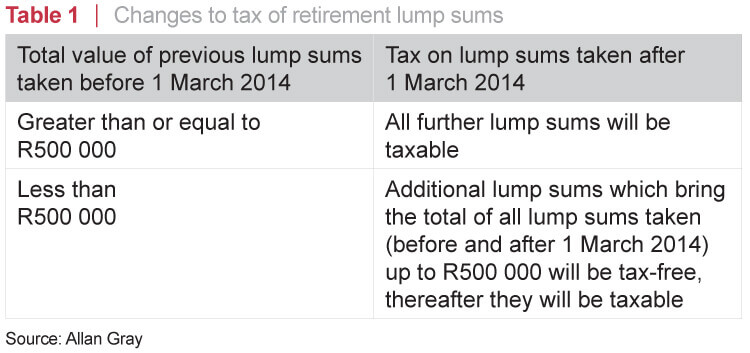The 2014 National Budget introduced changes to the retirement tax table. From 1 March 2014, the tax-free amount members and beneficiaries can take as a lump sum pay-out from retirement funds increased from R315 000 to R500 000 (the previous and new tax tables are included in the Appendix).
The increased tax-free allowance should not tempt you to reduce the money you need to put aside to fund a monthly income
Your pension income could be funded from a guaranteed pension, a living annuity, or a simple unit trust investment. The increased tax-free allowance should not change your assessment of how much you need in total to invest to fund your income. It is now quite common for people to live for a long time after they retire. This can put a strain on retirement savings: the risk that you outlive your savings is a real risk and it has potentially very unpleasant consequences. The financial decisions made when you retire require a sober assessment of your capital, your time horizon, your appetite for risk and the returns you will need to fund your lifestyle.
If you are not planning to spend the tax-free lump sum immediately, depending on your circumstances, it may be better to buy a living annuity and take a small or zero lump sum, or to take the full tax-free lump sum and invest this directly. Simply investing the tax-free lump sum gives you the maximum discretion on how and when to spend it. Living annuities have advantages too: in a living annuity you will not pay tax on the returns you earn, only on the money you draw as an income. Living annuities also are not part of your estate and thus do not attract estate duty. Living annuities restrict how much you may take out each year, which could be positive for discipline (also for your heirs’ discipline) or very negative if you have an emergency.
A good independent financial adviser or financial coach will help you to work through these decisions; it is also often helpful to ask for more than one opinion.
Tax calculations on lump sums from retirement funds after 1 March 2014 apply a higher lifetime cap but are not retrospective
When a retirement fund member or beneficiary takes a cash lump sum from a retirement fund at retirement or upon the death of the member, the retirement tax table prevailing at the time determines the amount of tax to be paid. All the benefits received or accrued on or after 1 October 2007 are added together to calculate how much tax is owed. A portion of this amount is tax free. This tax-free amount is a ‘once-in-a-lifetime’ benefit, irrespective of the number of retirement funds to which a taxpayer belongs, and is reduced by any retirement lump sums or withdrawals taken previously, for example, when the taxpayer changed jobs and took a cash lump sum.
Before 1 March 2014, no tax was levied on the first R315 000 of cash lump sums taken at retirement. On 1 March 2014, the retirement tax tables changed and the portion of retirement savings that one is permitted to take as a tax-free lump sum at retirement increased from R315 000 to R500 000.
Note that just because the tax-free amount increased by R185 000, it does not mean that R185 000 of your next retirement lump sum taken after 1 March 2014 will be tax free – the R500 000 ‘lifetime’ cap applies as shown in Table 1:

Mr A retired from ‘retirement annuity 1’ before March 2014 and took a cash lump sum of R450 000, receiving R315 000 tax free. After 1 March 2014, Mr A decided he also wants to retire from ‘retirement annuity 2’ and would like to take a cash lump sum of R185 000.
R50 000 of the lump sum taken will be tax-free and R135 000 will be taxable, with the tax being calculated as follows:
Step 1: Calculate the tax on the total lump sums taken (apply the retirement tax table post 1 March 2014)
Total lump sums taken = R450 000 + R185 000 = R635 000
Tax on total lump sums taken = (R635 000 – R500 000) x 18% = R24 300
Step 2: Calculate the tax on the previous lump sum taken (applying the retirement tax table post 1 March 2014)
Tax on previous lump sum taken (R450 000) = R0 (the amount falls within the R500 000 tax-free portion)
Step 3: Calculate the tax on the current lump sum taken (post 1 March 2014)
Tax on current lump sum taken (R185 000) = Tax to be paid on total lump sums less tax that would have been paid on previous lump sums
= R24 300 – R0
= R24 300
